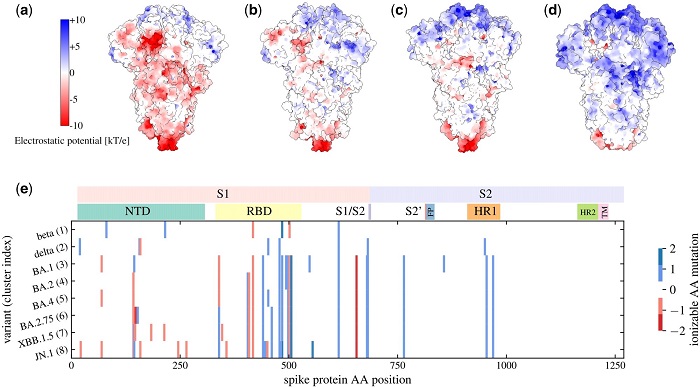Emerging Lineages Of SARS-CoV-2 Exhibit Changes In Total Charge On Spike Protein
Nikhil Prasad Fact checked by:Thailand Medical News Team Apr 23, 2024 1 year, 8 months, 2 weeks, 6 days, 10 hours, 55 minutes ago
COVID-19 News: The spike (S) protein of the severe acute respiratory syndrome coronavirus 2 (SARS-CoV-2) stands as a pivotal player in the virus's lifecycle. Responsible for mediating viral entry into host cells, the S protein is a prime target for understanding viral pathogenesis, transmission, and immune responses. Encoded within the viral genome, the S protein undergoes frequent mutations, particularly in regions crucial for its functionality. A new study covered in this
COVID-19 News report conducted by researchers from Jožef Stefan Institute-Slovenia and University of Chinese Academy of Sciences, Beijing-China has found that emerging lineages of SARS-CoV-2 exhibit changes in total charge on spike protein.
 Mutation-Induced Changes in Spike Protein Charge
Mutation-Induced Changes in Spike Protein Charge
Mutations in the S protein often led to alterations in its charge due to changes in ionizable amino acids. These modifications not only impact the protein's structure but also influence its interactions with host cell receptors, such as the angiotensin-converting enzyme 2 (ACE2). Notably, recent studies have highlighted a trend where mutations in SARS-CoV-2 variants increase the overall positive charge on the S protein, potentially affecting viral infectivity and transmissibility.
Charge Distribution in Spike Protein Domains
Examining the charge distribution within the spike protein reveals intriguing dynamics. While the stalk part (S2 domain) tends to exhibit a negative charge, the top region (S1 domain) and the receptor-binding domain (RBD) maintain a predominantly positive charge across various physiological pH ranges. This nonuniform charge distribution plays a vital role in stabilizing the spike protein, enhancing receptor attachment, and facilitating viral entry into host cells.
Evolutionary Trends and Lineage Analysis
The evolutionary trajectory of SARS-CoV-2 lineages unveils interesting patterns regarding spike protein charge dynamics. Previous studies have observed a consistent increase in positively charged amino acid residues in the S protein of emerging variants, contributing to enhanced viral binding and infectivity. However, recent analyses indicate a plateau in this charge increase with newer lineages, suggesting a potential shift in viral adaptation strategies.
Comprehensive Analysis of SARS-CoV-2 Lineages
A comprehensive study encompassing nearly 2200 SARS-CoV-2 lineages from the onset of the pandemic until December 2023 sheds light on evolving charge dynamics. This analysis reveals that the steady increase in positive charge on the S protein halted post-omicron variants, with subsequent lineages exhibiting greater variability in total charge. Clustering these lineages based on ionizable amino acid changes provides insights into distinct major clades and their evolutionary trajectories.
Functional Implications of Spike Protein Charge
Understanding the functional implications of spike protein charge dynamics is crucial. The charge distribution on the S protein impacts viral stability, membrane interactions, and host immune responses. N
otably, variations in charge can influence viral fusion events, receptor binding affinity, and susceptibility to environmental factors such as pH fluctuations.
Structural Insights and Future Directions
Detailed structural analyses are imperative to correlate specific mutations with local charge changes and their effects on S protein domains. Mutations primarily occurring in the S1 domain, particularly in the N-terminal domain (NTD) and RBD regions, play a significant role in shaping overall protein charge and functional properties. Future research directions should focus on elucidating the structural basis of charge dynamics and their impact on viral infectivity and host immune recognition.
Implications for Viral Pathogenicity and Therapeutic Strategies
The evolving charge dynamics of the SARS-CoV-2 spike protein have broader implications for viral pathogenicity and therapeutic interventions. Understanding how charge alterations influence viral fitness, immune evasion, and disease severity is critical for developing targeted antiviral therapies and vaccines. Additionally, insights into charge-based interactions with host factors, such as antimicrobial peptides, provide avenues for exploring novel treatment modalities against COVID-19.
Conclusion
The dynamic evolution of charge within the SARS-CoV-2 spike protein reflects the virus's adaptive strategies and interactions with host cells. Unraveling these charge dynamics enhances our understanding of viral pathogenesis, transmission dynamics, and immune responses. Continued research into spike protein charge alterations is essential for informing public health strategies, vaccine development, and therapeutic interventions in combating the COVID-19 pandemic.
The study findings were published in the peer reviewed journal: Bioinformatics Advances.
https://academic.oup.com/bioinformaticsadvances/article/4/1/vbae053/7642395
For the latest
COVID-19 News, keep on logging to Thailand Medical News.
